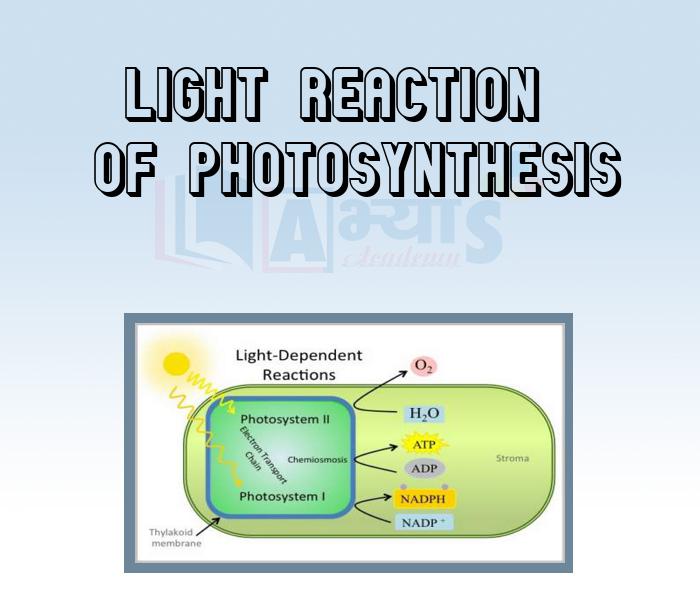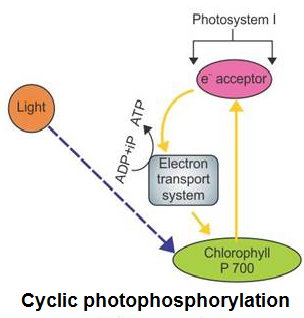Light Reaction of Photosynthesis













Light Reaction of Photosynthesis
The process of photosynthesis take place in two steps :
Light reaction includes the following steps, i.e., absorption of light, splitting of water, release of oxygen and finally the formation of high energy chemical intermediates, i.e., ATP and NADPH.
Absorption of Light :
Photosystems : - The light harvesting complexes or photosystems are made up of hundreds of pigment molecules bounded by proteins. Each photosystem has a photocentre or reaction centre, where actual reaction takes place.
This reaction centre contains a special chlorophyll-a molecule. It is fed by hundred other pigment molecules and it forms the light harvesting system called antennae. These antennae molecule absorb light of different wavelength, but shorter then reaction centre in order to make photosynthesis more efficient.
The reaction centre is different in both the photosystems as given below
Electron Transport : - The photosynthetic electron transport chain initiates with the absorption of light energy by the photosystem-II. The light of wavelength 680 nm is absorbed by the reaction centre of photosystem-II due to which a pair of electrons becomes excited and jump into an orbit away from the atomic nucleus. These electrons are then picked up by an electron acceptor, which passes them further to electron transport system consisting of cytochromes.
It is to be noted that this movement of electrons is downhill according to the redox potential scale (oxidation-reduction scale). The electrons of the electron transport chain are not used up in the chain instead they are further passed on to the pigment of PS-I.
Now, like the PS-II, the electrons in the reaction centre of PS-I also get excited on receiving red light of wavelength 700 nm and get transferred to the another electron acceptor with higher redox potential.
But this time the electron does not move to a reaction centre or chlorophyll-a. Instead, it moves to a molecule rich in energy and . On addition of these electrons the
gets reduced to
.
In 1960, Bendall and Hill discovered the Z-scheme of electron transport. It is a series of reactions that we have just studied above from the whole scheme of electron
transfer initiating from PS-II, uphill to the acceptor molecule, down the electron transport chain to PS-I, excitation of electrons and then their transfer to another acceptor and finally downhill to NADP in order to get reduced to .
Splitting of Water: - The electrons are continuously supplied to the photosystems-II by the available electrons, which get replaced due to the splitting of water.
In this process, the water splits into protons, electrons and oxygen. The complex for water splitting is associated with the photosystems-II that is located on the inner side of the thylakoid membrane. and
ions also play important role in the photolysis of water molecule.
These electrons thus, obtained by the splitting of water are needed to replace those electrons which are removed from the photosytems-I thus, are provided by photosystem-II.
While all the electrons formed, are replaced, the protons accumulated in the lumen of the thylakoid and the oxygen is evolved into the atmosphere.
Photophosphorylation: - Phosphorylation is the process through which, ATP is synthesised from ADP and inorganic phosphate (P) by the cell organelles (like mitochondria and chloroplasts). When it occurs in the presence of sunlight in chloroplast, it is called photophosphorylation.
Phosphorylation in mitochondria is not light dependent, but it uses the energy by oxidation of nutrients to produce ATP, hence it is called oxidative phosphorylation.
The process of photophosphorylation is of two types :
1. Non-cyclic Photophosphorylation : - Non-cyclic photophosphorylation is a type of photophosphorylation in which both the photosystems (PS-I and PS-II) in cooperate light driven synthesis of ATP. During this cycle, the electron released from PS-II does not return back to it hence, it is known as non-cyclic photophosphorylation. Both NADPH and ATP are formed during this reaction, are used in light independent reaction and are called reducing power.

2. Cyclic Photophosphorylation : - It is the type of photophosphorylation in which only PS-I is taking part and the electron released from the reaction centre .returns back to it after passing through a series of carrier, i.e., circulation takes within the photosystem and the phosphorylation occurs due to cyclic flow of electrons.

Site of light reaction in photosynthesis is ______________ | |||
| Right Option : C | |||
| View Explanation | |||
Dark reaction in photosynthesis __________________ | |||
| Right Option : A | |||
| View Explanation | |||
Students / Parents Reviews [10]
Abhyas is a complete education Institute. Here extreme care is taken by teacher with the help of regular exam. Extra classes also conducted by the institute, if the student is weak.

Om Umang
10thMy experience with Abhyas is very good. I have learnt many things here like vedic maths and reasoning also. Teachers here first take our doubts and then there are assignments to verify our weak points.

Shivam Rana
7thIt has a great methodology. Students here can get analysis to their test quickly.We can learn easily through PPTs and the testing methods are good. We know that where we have to practice

Barkha Arora
10thMy experience was very good with Abhyas academy. I am studying here from 6th class and I am satisfied by its results in my life. I improved a lot here ahead of school syllabus.

Ayan Ghosh
8thIt was good as the experience because as we had come here we had been improved in a such envirnment created here.Extra is taught which is beneficial for future.

Eshan Arora
8thAbhyas Methodology is very good. It is based on according to student and each child manages accordingly to its properly. Methodology has improved the abilities of students to shine them in future.

Manish Kumar
10thBeing a parent, I saw my daughter improvement in her studies by seeing a good result in all day to day compititive exam TMO, NSO, IEO etc and as well as studies. I have got a fruitful result from my daughter.

Prisha Gupta
8thMy experience with Abhyas academy is very good. I did not think that my every subject coming here will be so strong. The main thing is that the online tests had made me learn here more things.

Hiya Gupta
8thAbout Abhyas metholodology the teachers are very nice and hardworking toward students.The Centre Head Mrs Anu Sethi is also a brilliant teacher.Abhyas has taught me how to overcome problems and has always taken my doubts and suppoeted me.

Shreya Shrivastava
8thA marvelous experience with Abhyas. I am glad to share that my ward has achieved more than enough at the Ambala ABHYAS centre. Years have passed on and more and more he has gained. May the centre flourish and develop day by day by the grace of God.
